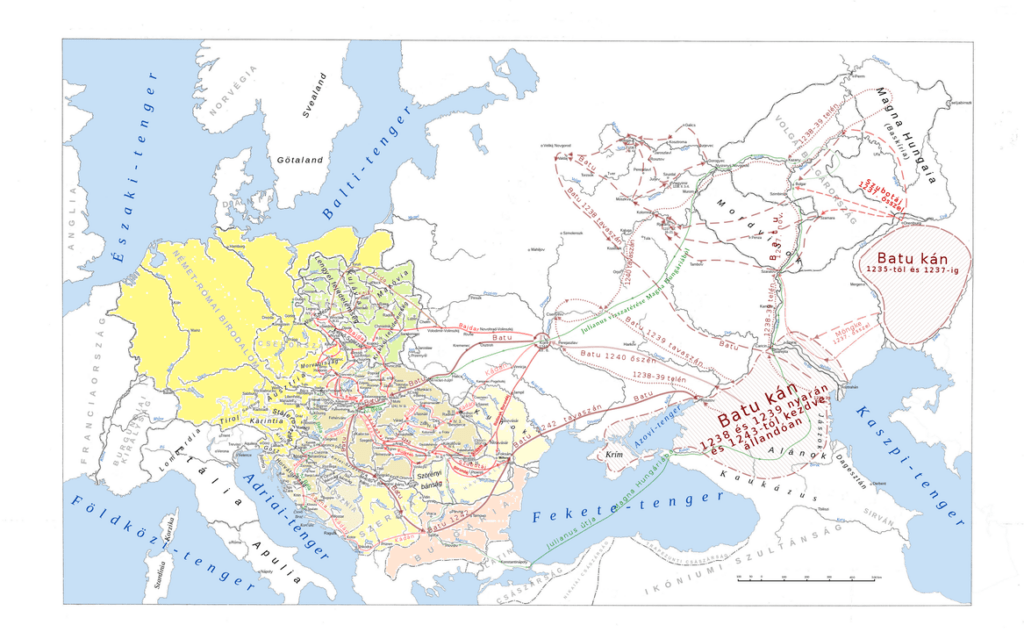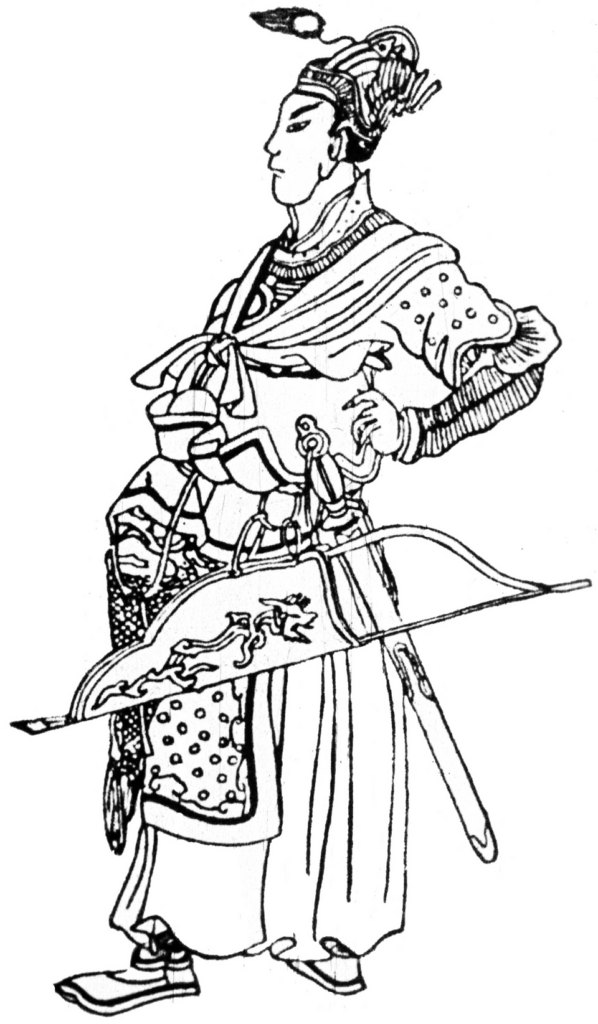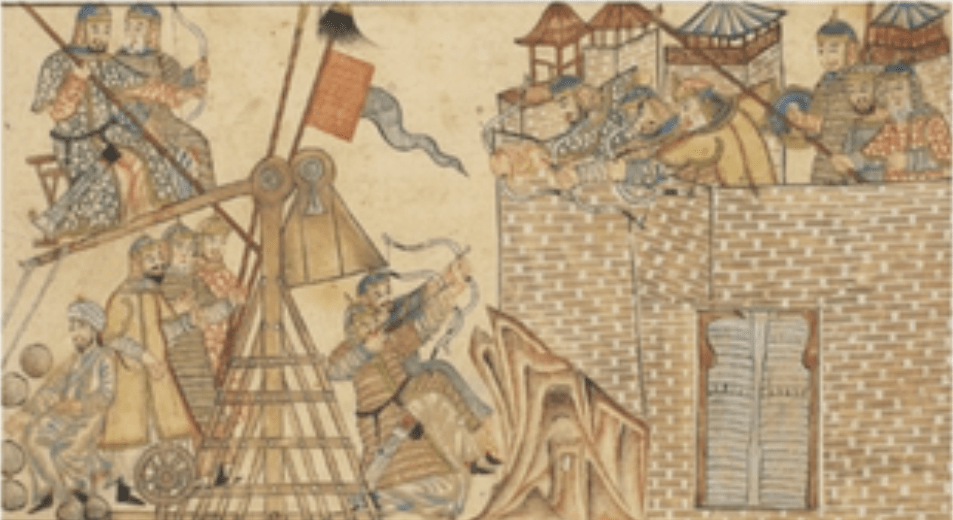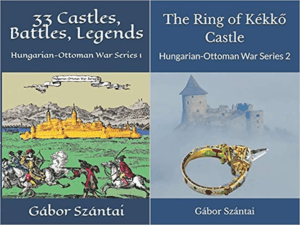The Mongols didn’t come here to get allied with the Hungarians, as it is sometimes recently viewed by some Hungarians who think the Mongols considered us as brothers.

The Battle of Muhi was the most famous battle during the Mongol Invasion of Hungary, when King Béla IV’s army suffered a crushing defeat at Muhi by the Mongol armies that had attacked the country. The battle was followed by a year-long occupation, which decimated the country’s population and turned much of its territory into a wasteland. However, some researchers doubt the size of the destruction, and the size of the devastation is thought to be exaggerated.

The battle took place on 11-12 April 1241, and the site was near the village of Muhi, at the confluence of the Sajó and Hernád rivers (today: Borsod-Abaúj-Zemplén county). On one side were the Mongol (we call them Tatar) armies led by Batu Khan and his commander Subutai, who attacked the Hungarian Kingdom, while the Hungarians led by King Béla IV, Prince Kálmán, and Archbishop Csák Ugrin were lined up on the opposite side.
The exact size of the clashing forces is not known, but it is assumed that the majority of the 90,000 Mongol forces attacking Hungary took part in the battle, while the Hungarians may have been represented by a few tens of thousands.

Before the battle, Batu Khan ordered his scattered raiding troops to join him and concentrated the Mongolian army, which was slowly retreating in front of the Hungarian army, on the left bank of the Sajó, in the corner formed by the Sajó, Hernád, and Takta. The Sajó River provided natural protection due to the spring snowmelt. Crossing was possible either on the ford upstream from the bridge or downstream towards the estuary, where the swelling effect of the Tisza River causes it to subside. The bridge was the only safe crossing of the river and was not destroyed by either party. In addition to heavy armoured cavalry, Béla’s army included light cavalry (some of them Besenyő / Pechenegs), Templar soldiers, and perhaps even Serbs.

Opposite him, the Hungarian army camped in the Muhi field on the right bank of the Sajó. The king set up camp opposite the only bridge on this stretch of the Sajó. To avoid being overwhelmed by the highly mobile enemy, Béla grouped the Hungarian troops in a large group formation. The camp of the Hungarians was surrounded by a typical wagon burg, with tents inside.

They were prepared for a long resistance because the wagons were not only chained together, but they also formed shield walls between them. The camp was built in a relatively small space (presumably due to the limited number of wagons available), which prevented the Hungarian army from developing and getting into fighting order at the decisive moment. According to Rogerius’ record, even in the face of the enemy, on the eve of the decisive battle, the unevenness and the agitation against the king did not cease:
“They wanted the king to lose the battle, so that they would be more agreeable to the king, so that he would honour them more, and they laughed at the king when he ordered a thousand men to take turns in defending the bridge over the Sajó River.”

The Mongol leaders, seeing that the Hungarians were only thinking of defence, went on the offensive. However, only a limited number of people were able to cross the bridge, so it could be safely defended by small units. A Russian deserter betrayed the Mongols’ plan, and Prince Kálmán, the king’s brother, and Archbishop Ugrin pushed back the Mongol troops already marching across the bridge in a fierce battle. The Mongols, therefore, retreated to their quarters on the opposite bank of the river, and the Hungarians returned to their camp with great satisfaction, believing that they had won the battle.

A small guard was left at the bridge. Batu’s main army attacked again at dawn, but now it also used stone-throwing machines to drive away the Hungarian crossbowmen, who had been very effective during the first unsuccessful Mongol attack and had caused great losses to the Mongols. This time, the Mongol troops led by Subutai found a ford on the right flank of the Sajó and crossed it. The Hungarian army then had to fend off a two-pronged attack, allowing Batu’s main forces to cross the bridge in increasing numbers.

The Hungarian armies, led by Prince Kálmán and Archbishop Ugrin, with the Templars at their side, successfully fought against Batu. The outcome of the battle was finally turned towards the Mongols by the cavalry units of Subotai, who arrived on the right flank of the Mongol forces. Until the delayed arrival of the right flank, the Mongols had suffered significant losses, and Chinese annals indicate that Batu was already considering withdrawing his troops because of the losses. It was here that 30 members of Batu’s armoured bodyguard and their lieutenant, Bakatu, were killed.

Around 7 a.m., the Mongols poured arrows into the Hungarian camp, which was already surrounded, and set it on fire. The Hungarian camp was in a state of disarray. In the narrow square, soldiers stumbled in the ropes of tents, and it was impossible to get into fighting order. The Mongols’ arrows made it impossible to leave the camp. There was no chance of a real battle; only small, disciplined troops could try to break through or push back the ring of Tatars by rushing out of the camp.

The Mongols also used rudimentary hand-held rockets acquired from the Chinese in their Eastern European campaigns, including Hungary. The survivors had to flee from the slaughter. The king was defended by his supporters, who protected him by sacrificing themselves, fled in the opposite direction to the great mass, northwest into the mountains, and found shelter.

My side note: his bodyguards were his warriors from Nyitra County, and my ancestor, Thomas Hercsuth, was among those who received a COA and a reward later for his deed. He could be among the elite troops called the lancers of Nyitra. Later, Thomas received the village of Bélaszállás (Bella) for his martial deed in 1248.

The Knights Templar, Prince Kálmán, and Archbishop Ugrin, with their troops, fought with desperate valour, but the Knights Templar were all killed, and Kálmán and Ugrin were forced to retreat, badly wounded. The Mongols then set fire to the camp, and headlessness became general. Everyone tried to flee. Some broke through the ranks of the Mongols, but most of them tried to escape through the gate that the Mongols had deliberately opened between their ranks so as not to provoke the large crowd of Hungarians to the point of despair.

Nevertheless, the battle lasted all day, and the camp’s defences must have been strong enough even without the constant flight of the refugees because, according to the Persian historian Dzhuvajní (1226-1283), the fighting did not stop after the Mongols had taken the royal tent. Even so, the Mongols did not completely take the camp until nightfall, thanks to the resistance of the Hungarians. Most of the Hungarian troops tried to flee along the road leading to Pest. However, the relentless pursuit, which was a characteristic feature of Mongol warfare as well as of the old Hungarian fighting style, completed the defeat of the Hungarian army. Very few were able to escape the carnage.

The king’s younger brother, Kálmán, though badly wounded, reached Pest on horseback and, crossing the Danube, escaped his pursuers but died of his wounds in May. The death toll of the army is unknown, but the Hungarian army was almost annihilated. Those who perished on the battlefield or during the pursuit were Archbishop Mátyás of Esztergom, Archbishop Ugrin of Kalocsa, Bishops Gergely of Győr, Bishop Ádám of Nyitra and Bishop Rajnald of Transylvania, Prelate and Vice-Chancellor Miklós of Szeben, Palatine Tomaj Dénes, Andor son of Szerafin, Judge of the Kingdom, Rátót Domokos, Chamberlain, and the Croatian Bán (Duke) Gutkeled Miklós.

However, the Mongols also suffered significant losses, probably in the tens of thousands. The Mongols won a major victory, which enabled them to plunder and ravage the Kingdom of Hungary. However, the Mongols did not achieve their desired goal because they did not succeed in capturing King Béla of Hungary in the battle, and despite the defeat, the Hungarians’ resistance did not cease. The defenders, who were entrenched in the fortresses, successfully defended several strongholds (Esztergom, Székesfehérvár, Pannonhalma, Nyitra, Fülek, Abaújvár, etc.) during the sieges.

According to some historians, the Hungarians’ ability to resist the Mongols so successfully that they had to withdraw in 1242 was a serious and unparalleled military achievement. The sudden departure of the Mongols is unlikely to have been triggered by the death of Grand Khan Ögödej because the Mongol Electorate (Kurultáj) elected a new Khan only years later, in 1246. The reason for the sudden retreat was more likely to be the losses suffered, the shortage of food and fodder in the devastated regions, and epidemics. The Hungarian army was not destroyed either, since Béla soon struck back at Frederick, who had blackmailed him and took back the three western counties that had been pawned off under duress.

It is also true that the Mongols wanted to take Hungary later, but they were repeatedly beaten back, and the last time they were defeated in 1285. It was due partly to the mixed warfare of the Hungarians (light and heavy cavalry) and the construction of many stone castles.

Dear Readers, I can only make this content available through small donations or by selling my books or T-shirts.
Please, support me with a coffee here: https://www.buymeacoffee.com/duhoxoxa
You can check out my books on Amazon or Draft2Digital. They are available in hardcover, paperback, or ebook:
https://www.amazon.com/dp/198020490X or at https://books2read.com/b/boYd81

My work can also be followed and supported on Patreon: Become a Patron!http://Become a Patron!
Become a Patron! Donations can be sent by PayPal, too: https://tinyurl.com/yknsvbk7


https://hungarianottomanwars.myspreadshop.com/all
Subscribe to my newsletter here: https://tinyurl.com/4jdjbfkn

